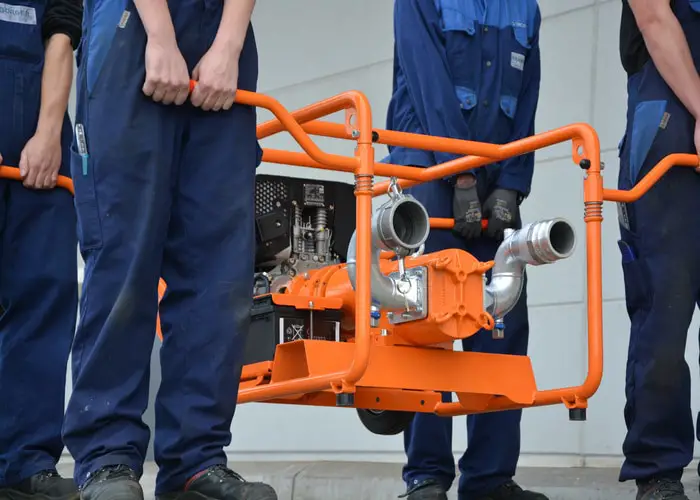If the first picture that pops into your head is that of a diesel-powered, generator-type unit, then fine; there will always be a need – but aside from diesel not striking the right environmental chords, what if your mobile pump has to meet the demands of ATEX?
Chalwyn valves and Spark Arrestors certainly do their job to meet Health & Safety requirements, but they do not, for example, control surface temperatures in the T4 range of 135°C. Such are the rigorous and sometimes complicated demands of ATEX that it is not uncommon for pump users to position control panels away from the ATEX area in order to comply with the regulation. Not the end of the world, but hardly what you’d call convenient.
For an increasing number in industry though, that first picture of a mobile pump is beginning to change instead to that of one with an electric-drive. “I think there’s still some lack of awareness that ATEX-approved electric-drive mobile pumps are available”, said David Brown, Managing Director of Borger.
“There must be”, he added, “because I’m quite shocked to see non-ATEX units still in use at some petrochemical sites”.
‘Electric-driven mobile pumps leave costly diesel units lagging way behind’
Borger sells mobile pumps that are diesel as well as electric, so Brown is keen to stress that he’s not on an anti-diesel crusade. Where needs must, especially for emergency use where no power supply is available, there are no end of Borger pumps in operation, including, for example, in the Republic of Ireland, where they are used to combat flooding. However, believes Brown, where mains power is available, electric-driven mobile pumps – lighter, far less cumbersome and so much better for the environment – leave costly (storage, transportation, labour) diesel units lagging way behind,
“Diesel usually has to be bought in bulk too”, continued Brown, “and there’s the time involved of having to keep topping up a diesel mobile pump – plus the fact that such a large amount of fuel is used. But in a potentially explosive environment, an ATEX-approved mobile pump is a must. Just recently for a petrochemical company, we built a customized ATEX-compliant mobile pump for transfer operations and removal of residues from storage tanks in an Ex zone 2 of their refinery”.
Brown explained how in order to be able to use the pump everywhere on the rough refinery premises, the mobile unit (including the drive) is mounted on a base-frame equipped with fork-lift openings and crane lifting eyes. A telescopic loader or a crane transports the pump to its respective application site. The fluids are often polluted with organic solids, so a filter system is in place to separate them out. Without hardly any pulsation, tri-lobe screw rotors pump the medium, with only the lobe tips of the rotors needing replacement in case of wear.
“The unit is operated from a fully ATEX-compliant control cabinet on the actual mobile unit”, says Brown. “This makes everything so much more convenient for the operator. If defined pressures or temperatures are exceeded, the pump switches off automatically. And in order to protect against uncontrolled pressure surges, the mobile pump is equipped with a Variocap and a bypass with rupture disks. Knowing that everything is ATEX-compliant provides great peace of mind”.
Borger has also recently supplied mobile pumps for a mineral oil company’s refinery. The entire pump unit, including the pump itself, the drive and the control technology had to be manufactured in ATEX-compliant design. For flexible use on the premises, the mineral oil company need to convey changing media and use the mobile pumps for “pigging” the pipelines – on the basis that the highest degree of safety would be met for the potentially explosive atmospheres
‘Moved through narrow aisles for transfer operations’
‘Mobile’ is self-explanatory of course, so there is no end to the number of uses of a mobile pump. A world away from the strict ATEX requirements at refineries, mobile pumps from Borger are also in use at……….. French vineyards. Custom-built, the stainless-steel pumps are moved through narrow aisles for transfer operations, with the wine producers able to set the required flow rate very easily via the control unit. Screw rotors convey the wine with low pulsation so that it does not foam up – whilst temperature sensors in the pump’s cover and pressure sensors in the suction and pressure lines ensure the highest level of safety and quality. The pump can be operated via the Borger control unit or the supplied remote control.
David Brown concluded: “Diesel-powered mobile pumps will always have an important role to play. But from refineries with their strict ATEX requirements – to vineyards – and for all types of applications, electric-driven, plug-in-and-play mobile pumps offer big advantages. For being lighter, far more cost-effective, safer and so much better on the environment, they are an attractive investment – and a very good hire option too”.

